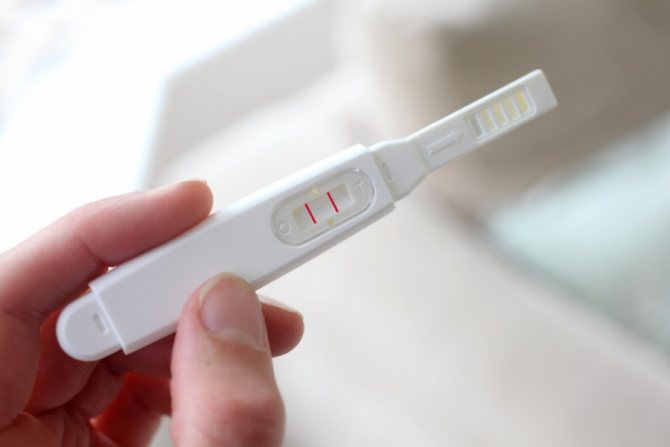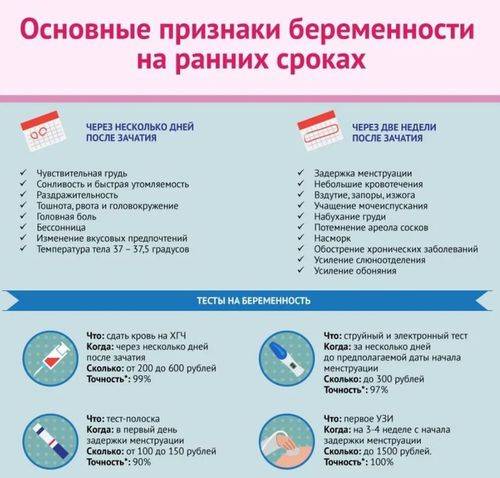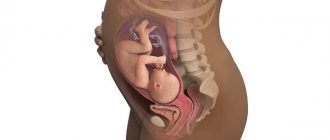05/24/2018 Category: Diseases and complicationsAuthor: Liya.kletnaya
The birth of a new life is not always a planned event for a woman. And if you find out about this a few months after conception, then there is no right to choose at all. There are situations when the main sign of pregnancy is absent. Menstruation continues and the woman learns about her interesting situation only by her rounded tummy. So what is a colored pregnancy and why is it dangerous?
- Symptoms
- Causes
- What does the test show during a “colored” pregnancy, what is the difference between washing and menstruation?
- Is there any danger
- Peculiarities
Washing in the early stages
Video: washing in early pregnancy
What is a “colored” pregnancy
It is a generally accepted opinion that pregnancy and menstruation are incompatible things. Women dreaming of a baby look forward to a delay in menstruation. For those who did not plan motherhood, its absence causes panic. But things are not always so simple.

Sometimes pregnancy comes as a big surprise
In 20% of cases, fetal development occurs in combination with continuous menstruation. This kind of pregnancy is called “colored”.
“Colored” pregnancy is very difficult to determine. The volume of discharge decreases as well as the duration, and the nature of the pain may also change. But these changes are so insignificant that often a woman does not attach any importance to them. Menstruation appears according to schedule in the first month, up to 3–4 months, or is present until childbirth. The last option is the rarest, but also more dangerous, since a woman learns about her interesting position in the long term by her expanding tummy. And weakness and nausea are attributed to stomach disease or poisoning. And instead of visiting a gynecologist, she ends up in a therapist’s office.

Signs of pregnancy can easily be confused with illness
Pregnancy accompanied by bleeding can lead to miscarriage or fetal death.
How is the fetus washed during pregnancy?
In most cases, a woman is able to distinguish the beginning of the monthly cycle from pathology of intrauterine development. But with an irregular onset of menstruation, this is quite difficult to do. In stressful situations or during viral infections, periods can shift, which leads to conception occurring without the woman knowing it.
When washing occurs, first of all, you need to pay attention to the amount and duration of bleeding. In ordinary life, in the absence of conception, the egg is released with heavy bleeding
The presence of scanty bloody mass indicates a pathological process occurring in the body or late attachment of the embryo to the uterus. The latter is often associated with previous surgical intervention (cesarean section, myomatous nodes).
At any trimester of gestation, a frozen pregnancy can occur, which occurs due to the presence of infectious diseases, genetic abnormalities, or as a result of injury. Bleeding, in this case, varies from minor to heavy.
The egg, when moving to the uterus, for various reasons, is able to attach anywhere. Most often this occurs in the fallopian tubes, less often near the ovary or cervix. Thus, an ectopic pregnancy occurs, accompanied by a damaged internal organ where the fertilized egg was implanted. Bleeding occurs, accompanied by pain, which can be confused with the monthly cycle. But, in such a situation, the duration will be very long.
Washing the embryo should not go unnoticed. It is imperative to inform the gynecologist about the presence of pathology in order to preserve intrauterine development and prevent the formation of complications.
- Lower back pain
- Lower abdominal pain
- Bloody vaginal discharge
- Heavy menstrual flow
- Scanty menstrual flow
Fetal washing is the popular name for the phenomenon of menstrual flow during pregnancy. Unlike bleeding, which can occur at any stage of pregnancy, washing the fetus is scarce and short-lived, which is why it does not pose a threat to the mother and baby in her womb. At the same time, such a phenomenon cannot be called the norm either, because it can be a sign of serious pathologies in a pregnant woman, so if discharge appears, she should consult a doctor.
Symptoms
The main sign of a “colored” pregnancy is a decrease in the amount of discharge. But a woman does not always attach importance to this. Symptoms characteristic of a normal pregnancy may also appear:
- nervousness;
- nausea in the morning;
- change in taste preferences;
- increased appetite;
- fast fatiguability;
- drowsiness;
- dizziness.
If your periods continue as scheduled for 3–4 months, you should be alert to the following changes:
- a slightly rounded belly may indicate not only weight gain, but also a colored pregnancy;
- strange movements in the abdomen should not be attributed to intestinal motility; these could be fetal movements.
If at least several of the above reasons are present, you should immediately visit a gynecologist. Otherwise, you may get a surprise in the form of news about a long-term pregnancy.
Symptoms
The symptoms of fetal washing are simple:
- discharge of various types (from smearing to heavy bleeding);
- painful sensations in the lower abdomen, radiating to the lower back.
In this case, symptoms arise only against the background of a positive pregnancy test or a confirmed pregnancy on an ultrasound.
The duration of such a phenomenon as washing the fetus can vary - from several days to several months. The faster the bleeding stops, the less likely the risk to the fetus and mother. If these signs are supplemented by the poor health of the pregnant woman, increased body temperature, weakness and malaise, there is a possibility that she is not faced with the washing of the fetus, but with a more severe intrauterine pathology, causing her to have a miscarriage. But even in such a situation, a timely visit to the doctor can correct the situation and prevent a miscarriage.
Causes
- If menstruation was observed only in the first month, then the cause was late ovulation. When ovulation occurs towards the end of the cycle, the fertilized egg does not have time to descend into the uterine cavity. And the body does not stop the maturation of the next one.
- Attachment of the fertilized egg to the wall of the uterus can cause spotting. As a rule, they are scanty and short-lived, but they can mislead a woman.
- Detachment of the fertilized egg in the early stages often ends in spontaneous miscarriage. With timely contact with a gynecologist and hospitalization, it is possible to maintain the pregnancy provided there is partial detachment. Complete detachment leads to termination of pregnancy.
- Placental abruption leads to bleeding, and without timely assistance, to fetal death.
- An ectopic pregnancy occurs when the egg does not have time to enter the uterine cavity and attaches to the fallopian tube. The fertilized egg continues to grow and damages the blood vessels, resulting in bleeding. As the egg grows, the mucous membrane of the fallopian tube cannot withstand it and it ruptures, which leads to egg detachment and miscarriage. The most unfavorable outcome of an ectopic pregnancy is external rupture of the tube, which is accompanied by bleeding into the abdominal cavity.
- Insufficient production of progesterone requires timely treatment.
- In very rare cases, menstruation continues throughout the entire period. This is due to the formation of a chorionic polyp in the cervix, which occurs due to disrupted hormonal levels.
Reasons for washing the fetus
This problem can appear for various reasons. Most of them are non-pathological in nature, i.e. does not pose a direct threat to the safety of pregnancy. This phenomenon can also be provoked by pathological factors that are dangerous to the health of the expectant mother and child. The table provides detailed information on why fetal washing occurs.
| Types of causes of fetal washing | Provoking factors | Description |
| Physiological | Formation of the embryo's circulatory system | The process of attachment of the fertilized egg to the wall of the uterus is accompanied by the continuous formation of blood vessels and arteries, which are responsible for delivering nutrients and oxygen to the fetus. Due to their thinness and increased fragility, they can be damaged, resulting in bleeding. |
| Hormone imbalance | Suppression of the production of progesterone, which is responsible for the cessation of menstruation when the egg is fertilized, leads to minor bleeding. | |
| Congenital abnormal structure of the uterus | With a bicornuate uterus, fetal development occurs in one of its horns, and in the other, endometrial rejection is observed, accompanied by bleeding. | |
| Pathological | Abruption of the placenta or ovum | This phenomenon occurs when there are serious pathologies in a woman’s body. |
What does the test show during a “colored” pregnancy, what is the difference between washing and menstruation?
The veracity of the test does not depend in any way on menstruation. The result rather depends on the integrity of the test strip manufacturer and the accuracy of following all recommendations for the procedure.
All pregnancy tests have the same operating principle, regardless of the brand. A reagent that reacts to the hCG hormone is applied to a certain area of the test.
Human chorionic gonadotropin (hCG) is a hormone whose elevated levels signal pregnancy. The content in the urine of an ordinary person does not exceed 5 MIU/ml; 10 days after conception, its amount increases 5 times.
When a pregnant woman's urine touches the reagent, it reacts instantly and the test strip shows two lines. If conception does not occur, there will be only one stripe.
Although manufacturers guarantee 100% results, errors still occur. But for the most part they come from improper use or too short a pregnancy.
I know of cases where the test gave a negative result both during a normal pregnancy and during a “colored” one. You should not trust only the test; it is better to go and get tested for the hCG hormone in the laboratory. This gives 100% results even in a short period of time.
Washing of the fetus occurs when conception has taken place and the body produces the hCG hormone in sufficient quantities so that pregnancy can be determined.
Symptoms and consequences of fetal washing
Blood discharge during pregnancy is commonly called fetal washing. This phenomenon is similar to menstruation, but since it stops from the moment of conception, there are completely different reasons behind this, which become dangerous for the unborn baby and mother.
Washing of the fetus can occur at different times, but more often this manifestation is observed in the first trimester, which indicates detachment of part of the uterus, which causes bleeding. In this case, specific manifestations of the disorder appear: pain in the lower back and lower abdomen, nausea, weakness of the body. Such unpleasant sensations may signal a problematic pregnancy.
Any unusual signs that have not previously appeared should lead to a gynecologist, who will already be able to determine why the fetus is washed.
The typical time for the onset of pathology is the onset of menstruation. This phenomenon can hide conception, so new signs during menstruation should alert you
It is important to pay attention to the course of menstruation, are there any changes, what is the nature of the discharge?
If the bleeding is insignificant and the woman feels well, this indicates uterine detachment, and such physiological manifestations do not threaten the normal course of carrying a child.
Causes of menstruation during pregnancy
Washing the fetus at different times can be a consequence of:
The beginnings of the formation of the baby's circulatory system: when he begins to develop, he needs nutrition and oxygen, which he receives through the placenta, but he also needs his own circulatory system for the entry and distribution of substances into his body. Fragile vessels can be damaged and burst at any time, which will lead to bleeding. There are no specific signs of the pathological condition, which complicates diagnosis at an early stage of the disorder; Hormonal imbalances in the body are the most common cause; symptoms typical for this condition already appear. Progesterone, which predominates during pregnancy, stops menstruation, but with its deficiency, menstruation can continue, but the discharge is insignificant. In addition to bleeding, the mother may actively gain weight, signs of constant fatigue and irritability appear, which is typical for normal menstruation; Detachment of the placenta or ovum is a dangerous reason for washing the fetus, as it can lead to the death of the baby
With such a deviation, the manifestations relate to the presence of blood discharge, toxicosis may occur, and in this case it is important to seek help from a specialist in a timely manner. The clinical manifestations of such deviations are not pronounced enough, but the presence of menstruation at different stages of pregnancy should already alert
The clinical manifestations of such deviations are not pronounced enough, but the presence of menstruation at different stages of pregnancy should already be alarming.
How it manifests itself
Washing of the fetus has the following signs, which do not always appear:
- pain in the lower abdomen and lumbar region;
- nausea, dizziness, anemic syndrome;
- minor bleeding.
All clinical manifestations characterizing fetal washing are typical for the menstrual period. When they appear, you need to immediately contact a gynecologist and undergo a series of diagnostic measures. Unlike a miscarriage, which can give similar symptoms, the washing of the fetus occurs with a slight release of blood. This is the main sign by which differential diagnosis is carried out.
Why is it dangerous?
The danger to the unborn newborn is determined by the reasons. In most cases, washing the fetus is dangerous for it and the pregnant woman. Continuing menstruation for several months of carrying the baby can lead to its freezing.
In addition, a woman may not be aware of successful conception and do things that are incompatible with her situation, which will also affect the condition and formation of the baby’s internal organs.
This includes smoking, drinking alcohol, and doing heavy physical work.
Fetal washing associated with placental abruption can also cause the death of the child in the early stages.
To be confident in her health, a woman should know the dangerous signs and contact a gynecologist about them.
As practice shows, a disorder in early pregnancy occurs in every 5 pregnant women, but 99% of such women carry the pregnancy without complications and give birth to an absolutely healthy baby.
Is there any danger
You should not reassure yourself that washing will not harm the fetus. First, it’s worth finding out the reason for this process. If the discharge is present only once after conception, then most likely there is nothing to worry about. But there are possible options for detachment of the fertilized egg. In this case, a miscarriage may occur or you will have to cleanse. Therefore, the main thing is to find out the reason in time to avoid negative consequences.
If washing continues at a later date, measures must be taken to ensure the full development of pregnancy and eliminate the causes that caused this phenomenon.
There are many examples of women who had a “colored” pregnancy giving birth to absolutely healthy children.
Reasons for washing the fetus
The phenomenon occurs due to insufficiently active production of the hormone progesterone. It is progesterone, reaching a certain organic concentration, that inhibits the menstrual cycle. If it is not produced enough, then menstruation continues for some time. Lack of progesterone may be an individual feature, or a consequence of long-term use of hormonal contraception. It can be easily eliminated by taking hormonal medications, or even on your own.
Fetal washing is sometimes called other non-pathological bleeding in early pregnant women:
- Implantation bleeding. After fertilization, the egg remains in the uterine cavity for some time, migrating through it. At the moment when it attaches to the endometrium, a small vessel may rupture.
- Changes in the circulatory system. After attachment of the fertilized egg to the endometrium, the entire attachment area is penetrated by many new vessels that provide nutrition to the fetus. In the early stages of formation, these vessels are inflexible, inelastic, and fragile. Vessels can burst, causing bleeding.
The duration of the phenomenon is approximately 2-4 days, it occurs with accompanying symptoms - slight pain in the lower abdomen and lower back.

Peculiarities
Not every woman knows enough about “colored” pregnancy. And knowing some of the features of this situation can prevent many negative consequences for mother and child.
Washing in the early stages
Washing in the first month occurs due to implantation of the fertilized egg into the wall of the uterus or due to late ovulation. Bloody discharge is very similar to menstrual discharge, only more scanty and short-lived. This process does not pose any danger if it is not accompanied by unusual pain.
If spotting is accompanied by abdominal pain, nausea, and fever, this indicates detachment of the fertilized egg and can lead to miscarriage.
Under no circumstances should such a process be ignored, as this can lead to the death of the embryo and health problems.
Video: washing in early pregnancy
Late washing
Bathing in the second and third trimester is more dangerous. Usually it indicates placental abruption. If you do not receive medical help in time, this can lead to problems with the development of the fetus or its death. In this case, it is better to carry out treatment in a hospital, where you can get qualified help at any time. This will save the life of the child and the health of the mother.
Video: bleeding in the 3rd trimester
Washing the fetus during pregnancy
As you know, in the process of bearing a child, many accompanying factors arise, in particular the washing of the fetus.
This is an informal term for the presence of spotting during the first trimester of pregnancy. Most often, these discharges are not too abundant, rather spotty. What is the danger of washing the fetus during pregnancy? Medical practice shows that, as a rule, women with a similar syndrome successfully give birth to healthy children. Let's look together at all the questions that concern pregnant women and try to answer them.
Why is the fetus washed?
- Formation of new blood vessels. By attaching to the walls of the uterus, the embryo provokes the formation of a whole “network” of new vessels around it. After all, from now on it is necessary to deliver much more blood. However, these vessels are extremely fragile and thin, which usually leads to damage. As a result, the expectant mother may notice the appearance of short-term spotting.
- Detachment of the placenta or ovum. In such a situation, this is a clear sign of a danger to further pregnancy. There are cases when a pregnant woman believes that these bleedings are a wash of the fetus, waiting for everything to pass on its own. However, it is strictly forbidden to ignore this situation and seek help from a doctor as soon as possible. Because this case cannot be delayed, otherwise it can lead to pathologies in the development of the child or to his loss.
- Hormonal imbalance. As we all know, all processes are “subject to” the powerful force of hormones. If there is insufficient amount of progesterone in a woman’s body, there will most likely be obvious signs of fetal washing. You may ask why? The thing is that from the moment a child is conceived, new cells must stop maturing. Progesterone or the so-called pregnancy hormone is “responsible” for this process. Sometimes the hormone is produced by the corpus luteum in insufficient quantities, resulting in signs of pregnancy.
How does washing the fetus threaten pregnancy? However, there are situations when a pregnant woman has no idea that the development of a new life has already begun inside her.
In such cases, the woman mistakes spotting for the onset of menstruation (if the date matches). Ignorance of this kind can lead to damage to the unborn child, just like drinking alcoholic beverages, smoking, long working hours and poor working conditions. Thus, you should be especially careful about your menstrual cycle, promptly noticing any suspicious signs.
What do women themselves think about washing the fetus?
If you study the opinions of women “with experience”, then almost everyone recommends that if you notice bloody discharge, consult a doctor immediately. Next, the specialist will independently determine what exactly the patient has: a threatened miscarriage or an ongoing pregnancy. For example, consider the situation of one of the participants in the women’s forum.
A woman talks about how she experienced spotting at 10-20 weeks. After contacting a specialist, an ultrasound examination revealed that everything was normal. Therefore, this begs the question, what is the reason? Doctors were not immediately able to make a diagnosis. However, in the end it turned out that the woman had had the fetus washed.
Moreover, there is another story. A pregnant woman experienced slight spotting throughout the first trimester, which she successfully mistook for menstrual discharge. However, things were not so rosy.
Therefore, if there is bleeding of unknown origin, a woman should consult a specialist in order to exclude serious complications, in addition to washing the fetus.
Do you have any doubts about the possibility of conceiving a child? We just buy a pregnancy test, it will show whether you are pregnant or not. However, under no circumstances should you put off going to the doctor.
It seems to us that everyone will agree with the opinion that the presence of bloody discharge is an alarming signal, in which case not only a timely reaction is extremely important, but also active actions to eliminate the manifestation of possible complications.
| Cash assistance. Monthly allowance for a single mother. |
| Diagnosis and treatment of mycoplasmosis. |
| Pyelonephritis during pregnancy |
| The drug Rinofluimucil |
Danger of pathology for the fetus
Unfortunately, washing the fetus carries serious danger. If it lasts for several months, it can lead to fetal death or miscarriage. In addition, a woman who is unaware of pregnancy can perform actions that are unacceptable for such a period: active sports, physical activity, smoking, etc. Because of this, the fetus seriously suffers.
If this condition is associated with placental abruption, then this directly threatens the death of the baby, as well as a deterioration in the woman’s condition. The risk is quite high, so you need to know how to determine the washing of the fetus, monitor your health, any changes in the body and seek medical help in a timely manner.
As practice shows, symptoms of fetal washing both in the early and later stages of pregnancy are observed in every fifth woman. And almost 99% of these women give birth to completely healthy children. But only if the pregnancy takes place under the strict supervision of a specialist. But ignoring the symptoms of fetal washing and inaction on the part of the mother can lead to significant pregnancy complications, including miscarriage and subsequent infertility of the woman.
Going through the entire pregnancy period without problems is the dream of every woman. However, this is not always possible. The discovery of any pathology should not put you in a state of panic, but it is extremely important not to ignore the symptoms that appear and immediately consult a doctor. Be attentive to yourself and listen to your body, because the health of your future baby depends on it!
Washing the fetus is menstrual flow, which cannot be avoided during pregnancy. But they should not be confused with bleeding, as they can occur at any time. The expectant mother should be aware of the seriousness of this process, as it causes serious damage to health.
But at the same time, this process cannot be called the norm, since it is not so, because as a rule, this is a signal that serious pathologies have begun in the body; naturally, they cannot be ignored. First of all, you should seek help from your attending physician, who will select the best treatment for this problem.










